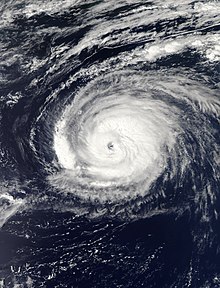|name=. Remove this parameter; the article title is used as the name by default. Hurricane Paulette just before its peak intensity north of Bermuda on September 14 | |
| Meteorological history | |
|---|---|
| Formed | September 7, 2020 |
| Post-tropical | September 22, 2020 |
| Dissipated | September 28, 2020 |
| Category 2 hurricane | |
| 1-minute sustained (SSHWS/NWS) | |
| Highest winds | 105 mph (165 km/h) |
| Lowest pressure | 965 mbar (hPa); 28.50 inHg |
| Overall effects | |
| Fatalities | 2 total |
| Damage | ≥$50 million (2020 USD) |
| Areas affected | Cape Verde, Bermuda, East Coast of the United States, Azores, Madeira |
| IBTrACS | |
Part of the 2020 Atlantic hurricane season | |
Hurricane Paulette was a strong and long-lived Category 2 Atlantic hurricane which became the first to make landfall in Bermuda since Hurricane Gonzalo in 2014, and was the longest-lasting tropical cyclone of 2020 globally. The sixteenth named storm and sixth hurricane of the record-breaking 2020 Atlantic hurricane season, Paulette developed from a tropical wave that left the coast of Africa on September 2. The wave eventually consolidated into a tropical depression on September 7. Paulette fluctuated in intensity over the next few days, due to strong wind shear, initially peaking as a strong tropical storm on September 8. It eventually strengthened into a hurricane early on September 13 as shear decreased. On September 14, Paulette made landfall in northeastern Bermuda as a Category 2 hurricane, while making a gradual turn to the northeast. The cyclone further strengthened as it moved away from the island, reaching its peak intensity with 1-minute sustained winds of 105 mph (169 km/h) and a minimum central atmospheric pressure of 965 mbar (28.5 inHg) on September 14. On the evening of September 15, Paulette began to weaken and undergo extratropical transition, which it completed on September 16. The hurricane's extratropical remnants persisted and moved southward then eastward, and eventually, Paulette regenerated into a tropical storm early on September 20 south of the Azores– which resulted in the U.S National Weather Service coining the phrase "zombie storm" to describe its unusual regeneration.[1][2] Paulette's second phase proved short-lived, however, as the storm quickly weakened and became post-tropical again two days later. The remnant persisted for several days before dissipating south of the Azores on September 28. In total, Paulette was a tropical cyclone for 11.25 days, and the system had an overall lifespan of 21 days (3.0 weeks).[3]
Paulette brought hurricane-force sustained winds and heavy rain to Bermuda, causing widespread power outages on the island. Paulette caused an estimated US$50 million in damage in the country.[4] Large swells affected the East Coast of the United States, and 2 people drowned off the coasts of New Jersey and South Carolina, respectively, after getting caught in rip currents generated by the hurricane. Minimal impacts were recorded in Azores from Paulette's second stint as a tropical cyclone.
- ^ Foerster, Jim (September 24, 2020). "What Is A Zombie Storm? Another First For The 2020 Hurricane Season". Forbes. Retrieved May 18, 2021.
- ^ Zdanowitz, Christina. "'Zombie' Tropical Storm Paulette returns from the dead because it's 2020". CNN. Retrieved May 18, 2021.
- ^ Latto, Andrew (April 1, 2021). Hurricane Paulette (PDF). Tropical Cyclone Report (Report). Miami, Florida: National Hurricane Center. Retrieved May 21, 2021.
- ^ Global Catastrophe Recap October 2020 (PDF) (Report). Aon. November 11, 2020. Retrieved November 11, 2020.